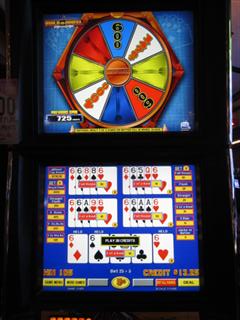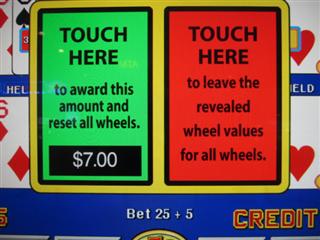On this page
Build a Wheel Poker
Introduction
Build a Wheel is a video poker variation I first saw at the Red Rock and Palace Station casinos in December 2011. Like Wheel Poker, the player is eligible to spin a prize wheel occasionally if he makes an additional bet. Unlike other such prize wheel games, though, in Build a Wheel the player fills in the slices himself whenever he gets a dealt three of a kind or better. When the wheel is full, the player gets to spin it.
Rules
- Build a Wheel may be played like ordinary 3-play or 5-play video poker. Alternatively, the player may make an additional bet to enable the Build a Wheel feature. This fee is equal to one full 5-coin bet for one hand. For example, if the player were playing 3-play video poker, then a max bet would be 20 coins — 15 for 3 lines at 5 coins each plus 5 coins to enable the Build a Wheel feature.
- The wheel consists of eight slices. The initial state is as follows:
- 6 blank slices.
- 1 slice with a win of 4,000 coins.
- 1 slice with a progressive win, with a seed value of 10,000 coins.
- If the player gets a three of a kind, straight, or flush on the deal, with the Build a Wheel feature enabled, then one slice will be filled in. The value assigned to the slice is random, with the following averages:
- Three of a kind: 650.00
- Straight: 952.50
- Flush: 1468.13
- If the player gets a full house or higher, with the Build a Wheel feature enabled, then all the remaining slices will be filled in. The value assigned to the slice is random, with the following averages:
- Full house: 938.46
- Four of a kind: 2188.46
- Straight flush: 4000.00
- Royal flush: 4000.00
- When the entire wheel is full, the player will spin it and win wherever it stops.
- As is usual with prize wheels, the stops are not equally weighted. I asked IGT, the game maker, about the wheel weightings. All they would tell me is each of the player-earned slices have an equal weighting. The two jackpot slices have a smaller weighting.
- All things considered, the average bonus win is just under 900 credits, according to IGT.
- If the player wishes to quit playing before he finishes filling in the wheel, he will be offered a surrender value to cash out and reset the wheel to the initial stage. I do not know how good these surrender values are.
Analysis
The following table shows the average wins for a three of a kind to flush on the deal. The lower-right cell shows an average slice value of 753.45 for one of these hands.
Three of a Kind to Flush Slice Values
| Hand | Average Win | Combinations | Probability | Expected Win |
|---|---|---|---|---|
| Flush | 1468.13 | 5,108 | 0.072743 | 106.80 |
| Straight | 952.5 | 10,200 | 0.145258 | 138.36 |
| Three of a kind | 650 | 54,912 | 0.781999 | 508.30 |
| Total | 70,220 | 1.000000 | 753.45 |
The following table shows the average wins for a full house or higher on the deal. The lower-right cell shows an average slice value of 1143.19 for one of these hands on the deal.
Full House or Higher Values
| Hand | Average Win | Combinations | Probability | Expected Win |
|---|---|---|---|---|
| Royal flush | 4000 | 4 | 0.000907 | 3.63 |
| Straight flush | 4000 | 36 | 0.008167 | 32.67 |
| Four of a kind | 2188.46 | 624 | 0.141561 | 309.80 |
| Full house | 938.46 | 3,744 | 0.849365 | 797.09 |
| Total | 4,408 | 1.000000 | 1143.19 |
Recall that if the player gets a full house or higher he automatically fills in the entire remaining wheel. Let's call the flush or lower wins a "Small Slice" and a full house or larger a "Large Slice." I won't get into the math, so take it on faith that the average number of large slices on a completed wheel is 1.125245, while there are 4.874755 small slices. The following table shows that assuming the player doesn't win either jackpot, his average bonus win will be 826.55 credits.
Average Earned Slices on Completed Wheel
| Slice Size | Average Number | Average Win | Expected Win |
|---|---|---|---|
| Large | 1.125245 | 1143.192668 | 214.395357 |
| Small | 4.874755 | 753.453547 | 612.150207 |
| Total | 6.000000 | 826.545564 |
However, there is an unknown chance the player will win one of the jackpot slices. All IGT would tell me is that overall the average wheel win is just under 900 credits.
The final table shows the return for various common games without the wheel feature enabled, 3-play return with the feature enabled, and 5-play return with the feature enabled. This table is based on an average wheel win of exactly 900 credits. Note that the return is always higher with the feature enabled, with the highest return for 3-play.
Average Return
| Game | Pay Table | No Wheel Return | 3-Play Return | 5-Play Return |
|---|---|---|---|---|
| Bonus Poker | 8/5 | 0.991660 | 0.993159 | 0.992659 |
| Bonus Poker | 7/5 | 0.980147 | 0.984524 | 0.983065 |
| Bonus Poker | 6/5 | 0.968687 | 0.975929 | 0.973515 |
| Bonus Deluxe | 9/6 | 0.996417 | 0.996727 | 0.996624 |
| Bonus Deluxe | 9/5 | 0.985495 | 0.988535 | 0.987522 |
| Bonus Deluxe | 8/6 | 0.984928 | 0.988110 | 0.987049 |
| Bonus Deluxe | 8/5 | 0.974009 | 0.979921 | 0.977950 |
| Double Bonus | 9/7/5 | 0.991065 | 0.992713 | 0.992163 |
| Double Bonus | 9/6/5 | 0.978062 | 0.982961 | 0.981328 |
| Double Bonus | 9/7/4 | 0.977414 | 0.982474 | 0.980788 |
| Double Bonus | 9/6/4 | 0.963754 | 0.972229 | 0.969404 |
| Double Double Bonus | 9/6 | 0.989808 | 0.991770 | 0.991116 |
| Double Double Bonus | 8/6 | 0.978949 | 0.983626 | 0.982067 |
| Double Double Bonus | 9/5 | 0.978729 | 0.983461 | 0.981884 |
| Double Double Bonus | 8/5 | 0.967861 | 0.975310 | 0.972827 |
| Triple Double Bonus | 9/7 | 0.995778 | 0.996248 | 0.996091 |
| Triple Double Bonus | 9/6 | 0.981540 | 0.985569 | 0.984226 |
| Triple Double Bonus | 9/5 | 0.970204 | 0.977067 | 0.974779 |
| Deuces Wild | 25/16/10/4/4/3 | 0.997283 | 0.997376 | 0.997345 |
| Deuces Wild | 25/15/9/4/4/3 | 0.989131 | 0.991262 | 0.990552 |
| Deuces Wild | 20/12/10/4/4/3 | 0.975791 | 0.981258 | 0.979436 |
| Deuces Wild | 25/16/13/4/3/2 | 0.967651 | 0.975152 | 0.972651 |
| Bonus Deuces Wild | 9/4/4/3 | 0.994502 | 0.995290 | 0.995027 |
| Bonus Deuces Wild | 8/4/4/3 | 0.990625 | 0.992383 | 0.991797 |
| Bonus Deuces Wild | 13/4/3/3 | 0.988025 | 0.990433 | 0.989630 |
| Bonus Deuces Wild | 12/4/3/3 | 0.982835 | 0.986540 | 0.985305 |
Surrender Option
I played the 25¢ 9-6 Double Bonus game (96.38% return) at the Suncoast until I reached a spin. After each slice earned I recorded the amount of the slice and surrender option. Here is what happened. All figures are in credits.
- First slice was 700. Surrender option was 81.
- Second slice was 575. Surrender option was 148.
- Third slice was 750. Surrender option was 236.
- Fourth slice was 525. Surrender option was 297.
- Fifth slice was 1,200. Surrender option was 437.
The purpose of recording information was to determine how generous the surrender options were. However, this brings up the issue of what the offer should be compared against. At first I assumed the player would play until he reached the wheel or took the surrender option, and then walked away. I assumed such a player would want to minimize his expected total loss. In doing so, the house edge of continued play would be considered as a cost to reach the bonus. I call this type "player 1."
The following table shows the expected bonus at each stage, the cost to reach that bonus (in terms of both the extra bet and house edge on the other three hands), the equity (expected bonus less cost to reach it), and the surrender offer for player 1. All figures are in coins. This is based on a jackpot of 10,627 coins at the time. I assume the probability of the big jackpot is the same as the 4,000-coin jackpot, of 1 in 168.1 for both.
Surrender Analysis — Player 1
| Total Sliced Filled | Total Earned Slices | Expected Bonus | Expected Cost to Reach Bonus | Equity | Surrender Offer |
|---|---|---|---|---|---|
| 1 | 700 | 875.29 | 857.81 | 17.47 | 81 |
| 2 | 1275 | 829.05 | 706.48 | 122.57 | 148 |
| 3 | 2025 | 814.61 | 545.65 | 268.96 | 236 |
| 4 | 2550 | 766.27 | 374.72 | 391.55 | 297 |
| 5 | 3750 | 832.46 | 188.63 | 643.82 | 437 |
Player 1 should accept the first two surrender options and reject the last three.
When I originally addressed the surrender option I mentioned player 1 only. However, Bob Dancer's article, A Further Look at Build A Wheel Poker caused me to rethink the way I looked at the surrender option.
If Build a Wheel has a return of over 100%, perhaps getting there with slot club points, then player 1 should never surrender. However, most of the time that isn't going to be the case. For recreational gamblers, who are playing against the odds for entertainment reasons, I think a better way to evaluate the surrender option is to assume the player will play a very large number of hands. So, if he plays the bonus or surrenders he will keep on playing. Let's call this person player 2.
In calculating wheel equity player 2 does not consider the house edge until the next spin, because he would keep playing either way. Here are how the same surrender offers would look to such a player.
Surrender Analysis — Player 2
| Total Sliced Filled | Total Earned Slices | Expected Bonus | Expected Cost to Reach Bonus | Equity | Surrender Offer |
|---|---|---|---|---|---|
| 1 | 700 | 875.29 | 773.69 | 101.60 | 81 |
| 2 | 1275 | 829.05 | 637.19 | 191.86 | 148 |
| 3 | 2025 | 814.61 | 492.14 | 322.48 | 236 |
| 4 | 2550 | 766.27 | 337.97 | 428.30 | 297 |
| 5 | 3750 | 832.46 | 174.13 | 658.33 | 437 |
Player 2 should reject every surrender offer, which range from 80% to 66% of equity.
To make a long story short, whether you are playing because you have an advantage, or just enjoy the game, then you should never surrender.
Advice
- Conventional video poker strategy should be used.
- Choose to play 3-play with the feature enabled.
- To minimize expected loss per spin, never surrender.






